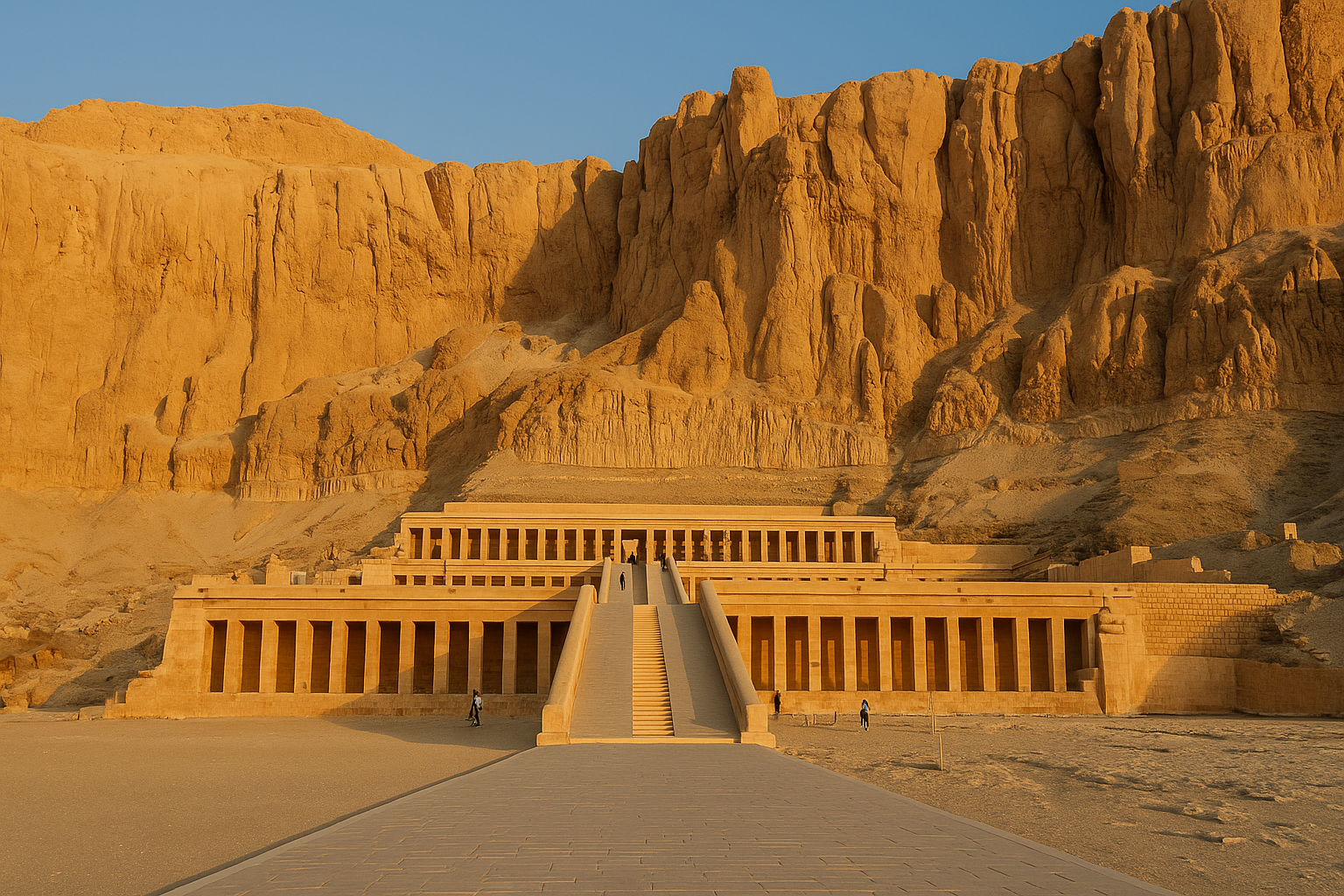Carved into the base of towering cliffs in Luxor’s Deir el-Bahari, the Temple of Hatshepsut stands as one of the most extraordinary architectural feats in ancient Egypt. A monument of elegance, power, and legacy, it tells the story of one of the few—and most successful—female pharaohs in history.
Unlike any other temple in Egypt, the Temple of Hatshepsut combines grace with grandeur, storytelling with symbolism. If you’re passionate about ancient history, female leadership, or remarkable architecture, this site is simply unmissable.
History and Design of the Temple of Hatshepsut
Built during the 18th Dynasty around 1479–1458 BCE, the Temple of Hatshepsut is a marvel of ancient Egyptian architecture and a reflection of one of history’s most powerful female rulers. Queen Hatshepsut, who boldly declared herself Pharaoh, oversaw a peaceful and prosperous reign, and her mortuary temple remains one of the most striking legacies of that period.
The temple was designed by her chief architect, Senenmut, and is unlike any other in Egypt. Rising in three grand terraces that mirror the cliffs of Deir el-Bahari, the structure seamlessly blends with the surrounding landscape. Each terrace is supported by elegant colonnades and connected by long, dramatic ramps, guiding visitors through a journey that once served both religious and royal ceremonial functions.
Reliefs carved into the walls of the temple tell stories of divine birth, expeditions to the mystical land of Punt, and offerings to the gods. These weren’t just mythological scenes—they were political affirmations of Hatshepsut’s right to rule, designed to establish her divine legitimacy.
The temple also functioned as part of her mortuary complex, where rituals were performed to honor her after death. Despite efforts by her successor, Thutmose III, to erase her name from history, the Temple of Hatshepsut endured. Its scale and elegance made it impossible to destroy, and today it remains a beacon of her enduring influence.
Situated near the Valley of the Kings and the Valley of the Queens, the temple’s location highlights its ceremonial significance. The site was built with astronomical precision—aligned to receive sunlight during the winter solstice, a symbolic connection between the heavens and the divine ruler laid to rest within.
Symbolism and Celestial Alignment
The Temple of Hatshepsut was more than a structure—it was a symbolic bridge between earth and the divine. Its alignment with the winter solstice allowed sunlight to penetrate deep into the sanctuary, illuminating the inner sanctum. This rare solar alignment reflected ancient Egyptians’ belief in cosmic harmony and divine order.
The temple’s design echoed the concept of Ma’at—balance, justice, and cosmic order. Its symmetrical terraces, harmonious proportions, and the integration with the cliffs embodied a deeper spiritual narrative about the pharaoh’s connection to the gods.
Architectural Legacy and Influence
The architectural approach used in the Temple of Hatshepsut set a new precedent for mortuary temples. Later constructions, such as the Ramesseum and the Temple of Seti I at Abydos, drew inspiration from its terraced design and symbolic layout.
The temple’s innovative use of open space, vertical structure, and narrative reliefs would go on to influence not just Egyptian temples but also how sacred sites were constructed across ancient civilizations.
Rediscovery and Restoration
Over centuries, the temple was buried under rock and debris. Its rediscovery in the 19th century marked a major milestone in Egyptology. Excavations by French and Polish archaeologists brought the temple back to life, and meticulous restoration continues to this day.
Efforts to reconstruct statues, preserve reliefs, and stabilize its structure have allowed modern visitors to witness the temple much as it once stood thousands of years ago.
Nearby Highlights in Luxor’s West Bank
The Temple of Hatshepsut is ideally located near several iconic landmarks:
- Valley of the Kings – Home to the tombs of Egypt’s most famous pharaohs, including Tutankhamun.
- Valley of the Queens – Burial ground for royal women and children.
- Medinet Habu – The mortuary temple of Ramses III, known for its colorful reliefs.
- Ramesseum – The funerary temple of Ramses II with a fallen colossal statue.
These nearby sites make the West Bank of Luxor a treasure trove for any traveler.
Tips for Visiting the Temple of Hatshepsut
- Best Time to Visit: Early morning or late afternoon to avoid heat and crowds.
- Entry Tickets: Available on-site or through tour operators.
- Dress Code: Light clothing, hat, sunglasses, and comfortable shoes.
- Duration: Plan to spend at least 1–2 hours exploring the site.
Our guided tours offer deep insights and convenient access:
Final Thoughts: Hatshepsut’s Enduring Legacy
The Temple of Hatshepsut is more than a temple—it’s a message from the past. It speaks of vision, resilience, and the indelible mark of a woman who rose above tradition to become one of history’s most remarkable rulers.
Visit this breathtaking site and witness a true marvel of ancient Egypt, one terrace at a time.
Plan your journey today at www.deltatoursegypt.com and follow in the footsteps of a queen who changed history.


Comment (0)